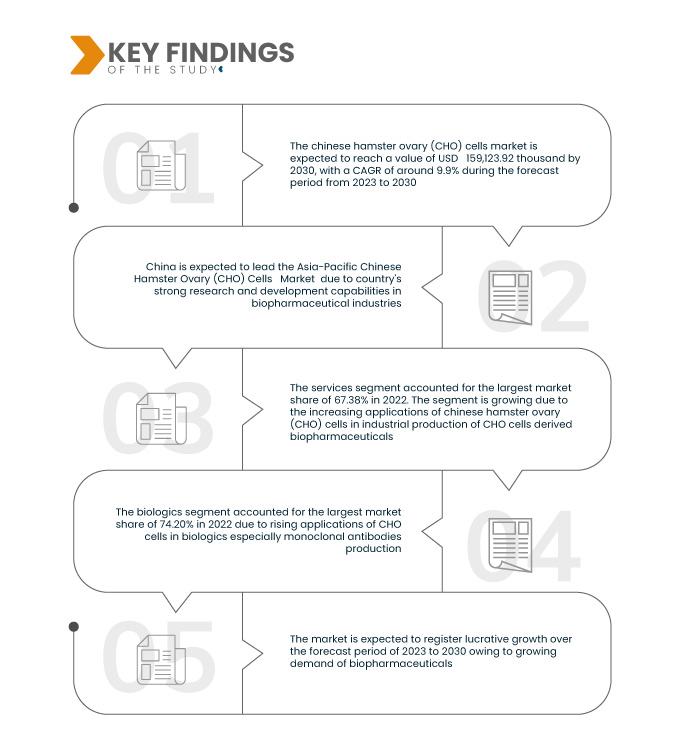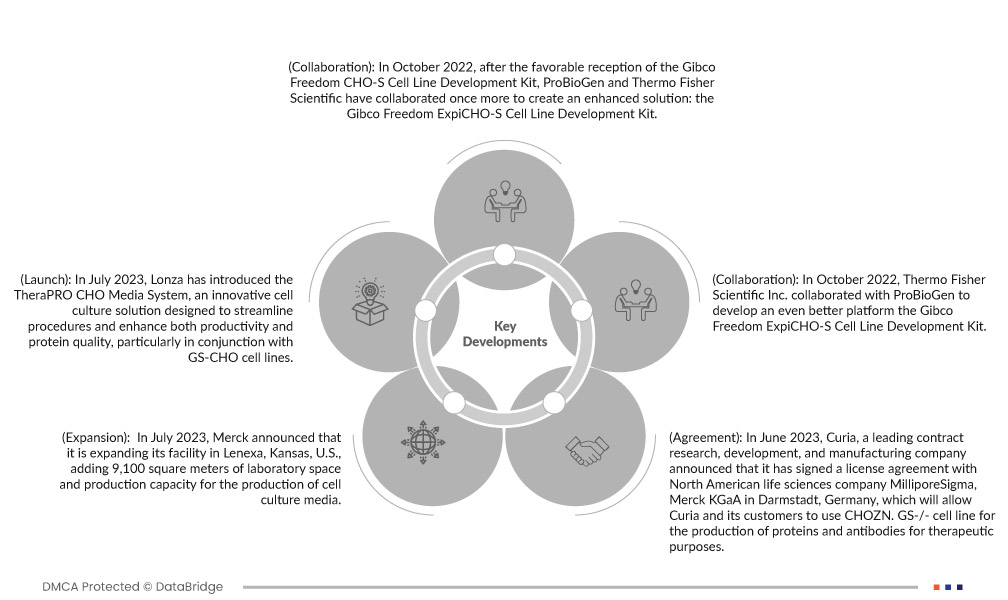The growing demand for biopharmaceuticals continues to be a powerful driver for the Asia-Pacific Chinese hamster ovary cells (CHO) market. This surge in demand is fueled by several factors. First, the aging population in Asia-Pacific and the increasing prevalence of chronic diseases have led to an elevated need for advanced therapies and medications. Biopharmaceuticals, which include monoclonal antibodies, recombinant proteins, and vaccines, offer targeted and highly effective treatment options for various medical conditions.
Second, the ongoing research and development of innovative biopharmaceuticals for previously untreatable or rare diseases contribute to the heightened demand for CHO cells. These cells serve as a fundamental component in the biomanufacturing process for producing these novel therapies.
Moreover, the trend toward personalized medicine, where treatments are tailored to an individual's genetic makeup, relies on biopharmaceuticals and, consequently, CHO cells in the production process. This individualized approach to healthcare further propels the market for CHO cells.
As a result, the growing demand for biopharmaceuticals not only reflects the increasing healthcare needs of the Asia-Pacific population but also underscores the critical role of CHO cells in fulfilling these requirements. This dynamic landscape positions the Asia-Pacific CHO cell market as an essential player in the global biopharmaceutical industry, with substantial opportunities for growth and development.
Access Full Report @ https://www.databridgemarketresearch.com/reports/asia-pacific-chinese-hamster-ovary-cells-cho-market
Data Bridge Market Research analyzes that the Asia-Pacific Chinese Hamster Ovary (CHO) Cells Market is expected to grow with a CAGR of 9.9% in the forecast period of 2023 to 2030 and is expected to reach USD 159,123.92 Thousand by 2030. The services segment is projected to propel the market growth owing to the increasing demand for specialized services related to CHO cell line development, bioprocessing, and contract manufacturing.
Key Findings of the Study
Rising Use of CHO Cells in the Genetic Study
The rising use of CHO cells in genetic studies is a significant driver for the Asia-Pacific Chinese hamster ovary cells (CHO) market. CHO cells have gained prominence in genetic research due to their adaptability and versatility in genetic manipulation and expression systems. Researchers and biotechnologists across Asia-Pacific are increasingly relying on CHO cells to investigate various aspects of genetics, including gene expression, genome editing, and functional genomics.
CHO cells provide a stable and well-characterized platform for genetic studies, making them an essential resource for understanding gene function, protein expression, and the development of new therapeutic agents. This heightened interest in genetic research using CHO cells not only fuels the demand for CHO cells but also drives innovations in biotechnology and genetic engineering techniques. Consequently, the Asia-Pacific CHO cell market is experiencing growth as it caters to the expanding needs of the scientific community engaged in genetic research and biotechnology, further solidifying its position in the life sciences sector.
Report Scope and Market Segmentation
|
Report Metric
|
Details
|
|
Forecast Period
|
2023 to 2030
|
|
Base Year
|
2022
|
|
Historic Years
|
2021 (Customizable to 2015-2020)
|
|
Quantitative Units
|
Revenue in USD thousand
|
|
Segments Covered
|
Type (Services and Product), System (Metabolic Selection System, Antibiotic Selection System, and Others), Application (biologics and Medical Research), End-user (Biopharmaceutical Companies, Biotechnology Companies, Clinical Development and Manufacturing Organizations, Clinical Research Organizations, Academic Institutes and Research Organizations, and Others), Distribution Channel (Direct Tenders, Retail Sales and Others)
|
|
Countries Covered
|
China, Japan, India, Australia, South Korea, New Zealand, Singapore, Thailand, Philippines, Malaysia, Indonesia, Vietnam, Taiwan, and Rest of Asia-Pacific
|
|
Market Players Covered
|
Thermo Fisher Scientific Inc. (U.S.), AcceGen (U.S.), RayBiotech Life, Inc. (U.S.), CLS Cell Lines Service GmbH (Germany), BPS Bioscience, Inc. (U.S.), GenTarget Inc. (U.S.), Merck KGaA (Germany), Promega Corporation (U.S.), Abeomics (U.S.), Applied Biological Materials Inc. (abm) (Canada), ATCC (U.S.), Sartorius AG (Germany), Lonza (Switzerland), Horizon Discovery Ltd. (U.K.), Cytiva (U.S.) and Curia global, Inc. (U.S.). among others
|
|
Data Points Covered in the Report
|
In addition to the insights on market scenarios such as market value, growth rate, segmentation, geographical coverage, and major players, the market reports curated by the Data Bridge Market Research also include depth expert analysis, and premium insights.
|
Segment Analysis
The Asia-Pacific Chinese Hamster Ovary (CHO) cells market is segmented into five notable segments based on type, system, application, end-user, and distribution channel.
- On the basis of type, the market is segmented into services and product
In 2023, the services in the type segment is expected to dominate the market.
In 2023, services in the type segment is expected to dominate the market with 67.66% market share due to the increasing demand for contract manufacturing and cell line development services, which offer flexibility and expertise to biopharmaceutical companies without substantial infrastructure investment
- On the basis of system, the market is segmented into metabolic selection system, antibiotic selection system, and others. In 2023, metabolic selection system segment is expected to dominate the market with 74.29% market share
- On the basis of application, the market is segmented into biologics and medical research. In 2023, the biologics segment is expected to dominate the market with 74.32% market share
- On the basis of end-user, the market is segmented into biopharmaceutical companies, biotechnology companies, clinical development and manufacturing organizations, clinical research organizations, academic institutes and research organizations, and others
In 2023, the biopharmaceutical companies in the end-user segment is expected to dominate the market
In 2023, the biopharmaceutical companies segment is expected to dominate the market with 43.42% market share due to rising applications of CHO cells in biopharmaceutical production and increasing demand for biopharmaceutical drugs.
- On the basis of distribution channel, the market is segmented into direct tenders, retail sales, and others. In 2023, direct tenders is expected to dominate the market with 68.16% market share
Major Players
Data Bridge Market Research analyses Sartorius AG (Germany), Lonza (Swizerland), Merck KGaA (Germany), Cytiva (U.S.), and Thermo Fisher Scientific Inc. (U.S.) as the major companies operating in Asia-Pacific Chinese Hamster Ovary (CHO) cells market.
Market Development
- In July 2023, Lonza introduced the TheraPRO CHO Media System, an innovative cell culture solution designed to streamline procedures and enhance both productivity and protein quality, particularly in conjunction with GS-CHO cell lines. This product launch is aimed at assisting pharmaceutical and biotechnology enterprises in their efforts to produce therapeutic proteins of higher quality and expedite their time-to-market
- In October 2022, After the favorable reception of the Gibco Freedom CHO-S Cell Line Development Kit, ProBioGen and Thermo Fisher Scientific collaborated once more to create an enhanced solution: the Gibco Freedom ExpiCHO-S Cell Line Development Kit. This advanced platform enables users to establish cell lines suitable for clinical development, even without possessing their own initial cells, vectors, or prior expertise in the domain. Leveraging their profound knowledge in cell line and process development, ProBioGen has significantly enhanced the performance of the Freedom ExpiCHO-S Kit
- In July 2023, Merck announced that it is expanding its facility in Lenexa, Kansas, U.S., adding 9,100 square meters of laboratory space and production capacity for the production of cell culture media. This expansion makes Lenexa the company's largest dry powder cell culture facility and a center of excellence in North America. The investment in the region reflects the company's strategy to expand and diversify its supply chain to meet current and future demand for cell culture platforms
- In June 2023, Curia, a leading contract research, development, and manufacturing company announced that it has signed a license agreement with North American life sciences company MilliporeSigma, Merck KGaA in Darmstadt, Germany, which will allow Curia and its customers to use CHOZN. GS-/- cell line for the production of proteins and antibodies for therapeutic purposes. Following the agreement, the CHOZN GS-/- cell line will be integrated into Curia's cell line development workflow and immediately available to Curia's customers
Regional Analysis
Geographically, the countries covered in the market report are China, Japan, India, Australia, South Korea, New Zealand, Singapore, Thailand, Philippines, Malaysia, Indonesia, Vietnam, Taiwan, and the Rest of Asia-Pacific.
As per Data Bridge Market Research analysis:
Chinais expected to dominate and be the fastest-growing country in Asia-Pacific Chinese Hamster Ovary (CHO) cells market during the forecast period 2023-2030
In 2023, China is expected to dominate and be the fastest-growing country Asia-Pacific Chinese Hamster Ovary (CHO) cells market due to country's strong research and development capabilities in biopharmaceutical industries.
For more detailed information about the Asia-Pacific Chinese Hamster Ovary (CHO) cells market report, click here – https://www.databridgemarketresearch.com/reports/asia-pacific-chinese-hamster-ovary-cells-cho-market












